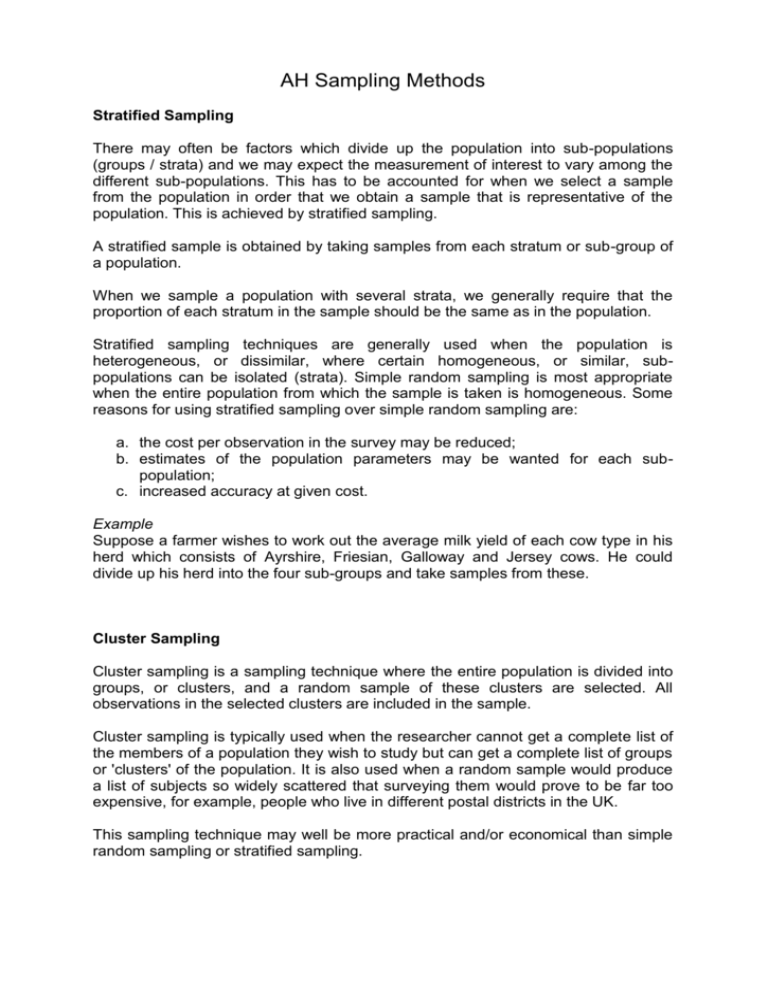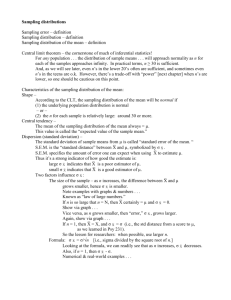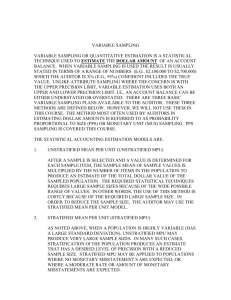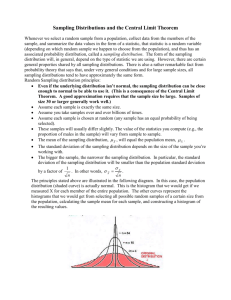AH Sampling Methods
advertisement

AH Sampling Methods Stratified Sampling There may often be factors which divide up the population into sub-populations (groups / strata) and we may expect the measurement of interest to vary among the different sub-populations. This has to be accounted for when we select a sample from the population in order that we obtain a sample that is representative of the population. This is achieved by stratified sampling. A stratified sample is obtained by taking samples from each stratum or sub-group of a population. When we sample a population with several strata, we generally require that the proportion of each stratum in the sample should be the same as in the population. Stratified sampling techniques are generally used when the population is heterogeneous, or dissimilar, where certain homogeneous, or similar, subpopulations can be isolated (strata). Simple random sampling is most appropriate when the entire population from which the sample is taken is homogeneous. Some reasons for using stratified sampling over simple random sampling are: a. the cost per observation in the survey may be reduced; b. estimates of the population parameters may be wanted for each subpopulation; c. increased accuracy at given cost. Example Suppose a farmer wishes to work out the average milk yield of each cow type in his herd which consists of Ayrshire, Friesian, Galloway and Jersey cows. He could divide up his herd into the four sub-groups and take samples from these. Cluster Sampling Cluster sampling is a sampling technique where the entire population is divided into groups, or clusters, and a random sample of these clusters are selected. All observations in the selected clusters are included in the sample. Cluster sampling is typically used when the researcher cannot get a complete list of the members of a population they wish to study but can get a complete list of groups or 'clusters' of the population. It is also used when a random sample would produce a list of subjects so widely scattered that surveying them would prove to be far too expensive, for example, people who live in different postal districts in the UK. This sampling technique may well be more practical and/or economical than simple random sampling or stratified sampling. Example Suppose that the Department of Agriculture wishes to investigate the use of pesticides by farmers in England. A cluster sample could be taken by identifying the different counties in England as clusters. A sample of these counties (clusters) would then be chosen at random, so all farmers in those counties selected would be included in the sample. It can be seen here then that it is easier to visit several farmers in the same county than it is to travel to each farm in a random sample to observe the use of pesticides. Quota Sampling Quota sampling is a method of sampling widely used in opinion polling and market research. Interviewers are each given a quota of subjects of specified type to attempt to recruit for example, an interviewer might be told to go out and select 20 adult men and 20 adult women, 10 teenage girls and 10 teenage boys so that they could interview them about their television viewing. It suffers from a number of methodological flaws, the most basic of which is that the sample is not a random sample and therefore the sampling distributions of any statistics are unknown. ystematic Sampling This is random sampling with a system! From the sampling frame, a starting point is chosen at random, and thereafter at regular intervals. For example, suppose you want to sample 8 street of 120 houses. houses from a 120/8=15, so every 15th house is chosen starting point between 1 and 15. If the starting point is 11, then the houses selected 56, 71, 86, 101, and 116. after a random random are 11, 26, 41, If there were 125 houses, 125/8=15.625, so should you take every 15th house or every 16th house? If you tak every 16th house, 8*16=128 so there is a risk that the last house chosen does not exist. To overcome this th random starting point should be between 1 and 10. On the other hand if you take every 15th house, 8*15=120 s the last five houses will never be selected. The random starting point should now be between 1 and 20 to ensur that every house has some chance of being selected. In a random sample every member of the population has an equal chance of being chosen, which is clearly no the case here, but in practice a systematic sample is almost always acceptable as being random. Advantages spreads the sample more evenly over the population easier to conduct than a simple random sample Disadvantages the system may interact with some hidden pattern in the population, e.g. every third house along th street might always be the middle one of a terrace of three Multistage Sampling Multistage sampling is any sampling where the elements are chosen in more than one stage. Multistag sampling can involve more than one method or combined method of sampling, such as simple random, cluster o stratified sampling. Additionally, multistage sampling uses a hierarchy of sampling units or clusters, so that a each stage each element belongs to only one sampling unit. The sampling unit created in the first stage is calle the primary sampling unit (PSU). It is important, especially in computing variance. Now try the Multiple choice test at the following website. A copy of this test is also in the 2002 folder in the sam sub folder that you opened to access this information, it is a Mozilla Firefox web link. file:///Q:/2002/Modern%20Studies/Research%20methods/Survey%20methods%20multiple%20choice%20test.htm









